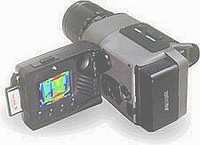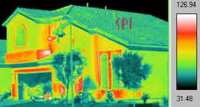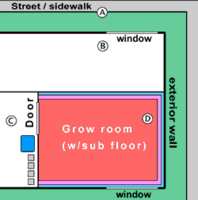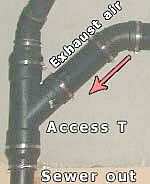Contributed by: snoofer
Images archived 2003

Infrared cameras are
widely used by law enforcement for border patrol, grow
room confirmation, and other surveillance operations.
There is legal debate as to whether this technology is
intrusive or non-invasive.
Growers fear IR
because it?s difficult to ?hide? invisible heat.
Protecting yourself against excessive heat emissions is
a good defensive measure. This FAQ focuses on masking
heat emissions.
What is infrared?
Light and heat energy warm objects, which then
re-radiate excess energy. Some of this excess energy is
emitted as low-energy infrared. IR is invisible to the
naked eye, but can be displayed and measured by
specialized cameras.
What does Leo look
for?
Officers are trained to look for hot spots on walls
and windows, unusually warm foundations, exhaust
emissions from vents and chimneys, and warming trends
typical of marijuana grow operations. Leo will wait
until evening or early morning (when the grow is up to
full temperature and the air is cool). He will also look
for light leaks, smells and other info at this time.
Note: Leo will try to image a suspected grow-op
from all angles, but is only legally able to do so from
public property (ie. Sidewalks, roads, public paths,
etc).
Note: power companies occasionally image
power pole transformers to see if they are abnormally
hot (problems), and to source power theft.
Legal implications (ExpensiveCloset)
"A thermal imaging scan does not intrude in any way into
the privacy and sanctity of a home?the privacy
associated with a home, are (not) threatened by thermal
imagery." (US supreme court ruling)
"The Supreme
Court ruled 5 to 4 on June 11 [2001] that police cannot
use infrared heat-detecting technology to gather
evidence from a private home without a search warrant"
High Times, October 2001 (Pg.20)
In Canada, IR
is used in the pre-investigation phase. Positive results
can then be used to obtain a search warrant.
Will Insulation help? Conventional
insulation will help block IR, but it is probably not
enough by itself. A fully insulated wall (R 40) will
hold heat much longer than a window (R 2). Concrete is a
good conductor of heat; after hours of HID lighting,
foundations will become abnormally warm.
Most
growers flower at night to take advantage of the
naturally cooler air; unfortunately, a warm grow house
will radiate lots of thermal energy compared to the cool
night air.
How do I mask my heat
emissions? Note: Small grows (under 2000w) would
probably not emit enough heat to warrant the effort or
expense.
Note: Reducing grow room temperature
will reduce heat emissions; however, the grow room will
still be warmer than surrounding basement rooms.
This technique creates a false wall to contain
cold air. Interlocking rigid foam panels prevent hot
grow room air from contacting and warming house walls.
Cold air is blown into the gap between the foam and the
walls for maximum protection. The wall?s exterior will
appear ?cold? to an IR camera, indicating a negative for
internal heat.
"Partial room" (insulate
exposed walls only)
"Room in a room" (entire rooms
are insulated)
*Floor. Concrete foundations
absorb heat readily. Build a sub floor to raise the
entire grow off the floor.
*Walls. Use
interlocking 1.5 or 2? foam insulation along all exposed
walls. Place the insulation 1-4? away from walls, fit
foam panels from floor to ceiling (some cutting may be
required), and blow cold air into the gap. Seal seams
and corners with tape. Cover walls with Mylar to reflect
heat back into the room.
*Windows. Windows are
essentially uninsulated, so you must fill the gap with
insulation. Draw the curtains/blinds, add black poly
behind, then add insulation.
Drawing
description
A ? Public property that Leo can image
from
B ? Internal basement room. Grow room heat
will still be noticeable, and this side needs
protection.
C -- ?Safe? basement rooms. Put
ballasts and reservoir outside to minimize heat
D ? Partially insulated growroom. The pink band
is the interlocking foam insulation, the blue band is
the cold air contained between the insulation and the
house walls. The window on the bottom of the picture can
be open to allow cold air to enter the air gap. Room
temperature air can also be blown in from an adjacent
basement room through a hole in the foam panels.
Hiding the Exhaust Safely exhausting
hot air is difficult; Leo looks for unusual heat
emissions coming from opened windows, chimneys, dryer
vents and other handy places. Note: running exhaust to
outside sheds, barns and tree stumps is well known to
Leo.
Exhaust down the sewer
Every house has a sewer vent standpipe. By venting
down the sewer, the exhaust will be chilled and smell is
distributed amongst you and your neighbors. The sewer
cleanout access is often a 3-way 4? abs ?T? with a
threaded cap somewhere in the basement. Remove cap, and
hook your blower to the T (A 4? to 3? adapter funnel may
be required) and run blower 24/7. This will not affect
normal use of the sewer
Cool exhaust with
water
Place a wet towel (wicking water from a
tray underneath) partially over the end of the exhaust.
Spraying water inside the exhaust pipe works as well.
Underground exhaust
Running the
exhaust through a long, buried pipe helps to cool the
air. Perimeter drains can be used for this.
Water-cooled lights
Running water
cooled lights is very effective; IR heat from the lights
are washed down the drain. Water cooled light systems
are currently difficult to source, and have drawbacks
including cost, condensation and leaks.
Tools
for the grower:
Note: most ?night vision?
devices use UV (ultraviolet) and not longwave IR
detection.
Engine heat ?guns?. +/- 1F. Numerical
readout, laser pointer.
"Night Vision" scopes,
cameras and camcorders.
Infrared film (Kodak High
Speed Infrared Film 2481)
Links:
Legal
Consumer IR engine guns:
Infrared film usage